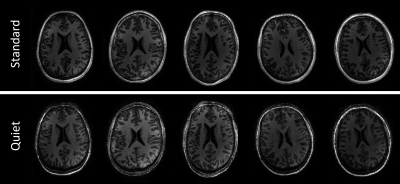Sarah M Jacobs1, Edwin Versteeg1, Leonie NC Visser2, Anja G van der Kolk1,3, Dennis WJ Klomp1, and Jeroen CW Siero1,4
1Department of Radiology and Nuclear Medicine, University Medical Center Utrecht, Utrecht, Netherlands, 2Alzheimer Center Amsterdam, Department of Neurology, Amsterdam Neuroscience, Vrije Universiteit Amsterdam, Amsterdam UMC, Amsterdam, Netherlands, 3Department of Radiology, the Netherlands Cancer Institute, Amsterdam, Netherlands, 4Spinoza Centre for Neuroimaging Amsterdam, Amsterdam, Netherlands
1Department of Radiology and Nuclear Medicine, University Medical Center Utrecht, Utrecht, Netherlands, 2Alzheimer Center Amsterdam, Department of Neurology, Amsterdam Neuroscience, Vrije Universiteit Amsterdam, Amsterdam UMC, Amsterdam, Netherlands, 3Department of Radiology, the Netherlands Cancer Institute, Amsterdam, Netherlands, 4Spinoza Centre for Neuroimaging Amsterdam, Amsterdam, Netherlands
We
have shown preliminary evidence that our silent gradient axis and readout
module incorporated into a T1-weighted MPRAGE sequence is perceived
more quiet and positive and delivers images of largely acceptable quality.

Figure 2: (A) Means (SD) of reported sound level
ratings directly after the scan (immediate) and after all scans (delayed) for the quiet compared
to the standard scan; (B) Means (SD) of comfort level, overall experience and
willingness to undergo scan again ratings for the quiet compared to the
standard scan. Asterisk indicates statistical significance.
